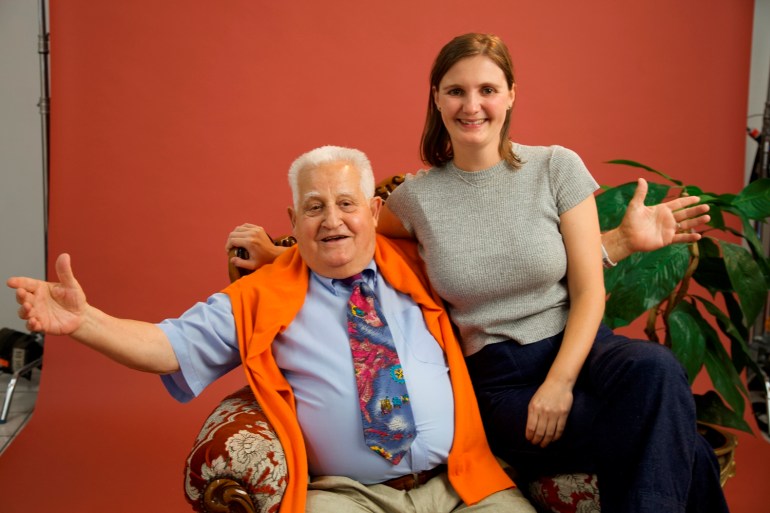Director Madeleine Martiniello had passed Franco Cozzo’s Footscray furniture showroom countless times.
One day, she had a lightbulb moment: Why had nobody ever told his story?
Italian-Australian Cozzo is undoubtedly Melbourne’s most famous and charismatic furniture entrepreneur, as well known for his ostentatious baroque furniture as his tri-lingual, low-budget ‘80s television advertisements proclaiming “Grand sale!”, “Megalo!” and “Foot-is-cray”.
Martiniello had bought into a modern myth that Cozzo’s stores were no longer open, with the Footscray shop seeming to keep odd hours, and the lights never fully on.
On a drive past, she thought: “It’d be really interesting to film this abandoned baroque showroom.”
“It’s so visually enticing and inherently cinematic, even though it’s very suburban and urban,” she tells IF.
“I thought there was something quite poetic about the aesthetic of the furniture and the space it was in.
“It was a combination of feeling like there must be something visually worth exploring through film, and then also knowing there must be some sort of interesting story there, because Franco Cozzo is a bit of an icon in Melbourne.”
A two minute Google revealed the shops were indeed still open, so Martiniello picked up the phone. Franco answered – despite being in his 80s, he still works at the Footscray store six days a week.
He invited Martiniello to the showroom, and while she didn’t have a completely formed idea of what she wanted to do, she wrote up him a document of what she imagined the film might be like.
It took a few weeks to get the initial okay, but longer to gain Cozzo’s trust. It helped that Martiniello had Italian grandparents.
“I innately understood his demeanour and cultural background; I knew how to interact with someone from that generation, because both my dad’s parents migrated at the same time as Franco from Italy. We bonded over that as well.”
It was a four-year process from the day Martiniello first pitched Cozzo, until the resulting film – titled Palazzo di Cozzo – premiered at Melbourne International Film Festival (MIFF) in August.
The story ebbed and flowed over that time too. Initially Martiniello was drawn to unpacking the pop culture status of Franco; how and why that had happened within a social and historical context.
However, a present-day, observational story also emerged about Cozzo coming to the end of his career.
“I wanted to look at whether he was still relevant to the local community as a figure of migrant success, but also to see how that has impacted him as well. That’s what took time to understand. What’s it like to be in a late chapter in your life, to have enjoyed a certain eccentric form of attention for most of it, and what happens when you have to reckon with letting go of that?”
Originally, the director had hoped to travel with Cozzo to his hometown in Sicily, which COVID put a stop to. That meant again, they had to rework the final arc of the film, in that it couldn’t be a ‘home journey’.
It was also a process for Martiniello as a filmmaker, for whom Palazzo di Cozzo is her first feature-length project. When she began filming, she was just one year out of the Victorian College of the Arts (VCA).
She shot about a year’s worth of footage on her own before she got some funding that allowed her to bring on cinematographer Vincent Lamberti. As a child of Italian migrants, who speaks fluent Italian, he was a valuable addition not only technically but in terms of gaining Franco’s trust.
“Across the road from Franco’s old store in the suburb of North Melbourne, Vincent’s dad owned an Italian music store. There was an instant connection.”
Palazzo di Cozzo is produced by Philippa Campey and Samantha Dinning, with whom Martiniello also made ABC Art Bites series The Unmissables. However, they had began working on Palazzo prior to, with Martiniello having initially just approached Campey for advice.
“She’s really supportive of young women directors, and often works with first-time directors,” Martiniello says.
“I was pretty overwhelmed with her being willing to support me having only just finished film school.”
With a majority of MIFF screenings moving online this year due to COVID lockdowns, Martiniello is yet to experience her film with an audience. However, due to demand, it had special additional screenings on MIFF Play.
“It was definitely odd, sitting in my lounge room thinking about people watching it for the first time in their homes,” she says.
“But from what I’ve gleaned from social media, and people sending me messages, people seemed to have really enjoyed the film. In a way, because it’s so Melbourne and it’s lockdown here, it had this nostalgic warmth people were yearning for. I think actually, in a weird way, it fed into this overhyped reaction.”
Palazzo di Cozzo will premiered in cinemas that are open yesterday via Sharmill Films, and will screen on the ABC at a later date. Martiniello is hopeful the film will connect with people around Australia, not just Melburnians – that they will enjoy Cozzo’s charisma and joy de vivre, and reflect on his migrant story and the meaning of home.
“I hope they understand the unique pop culture realm that he exists in, and have a chance to think about whether there’s someone similar in their home city.
“Or just reflect on the confluence of the migrant wave Franco came on, and then the media he harnessed. Incidentally, he arrived in 1956, which is the year television arrived in Australia as well.”
Palazzo di Cozzo is in select cinemas now.


